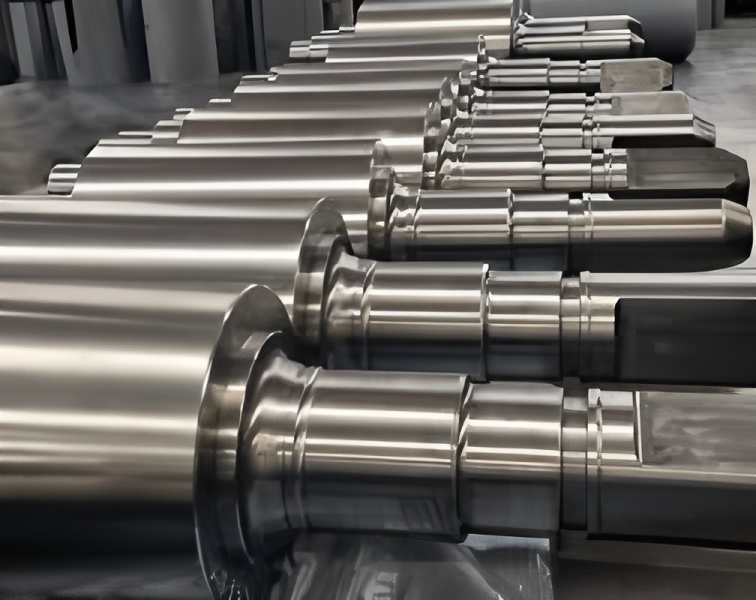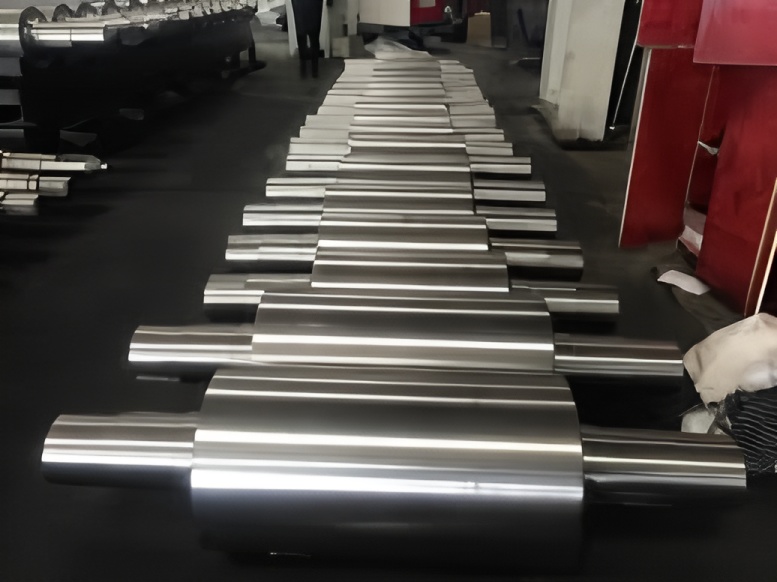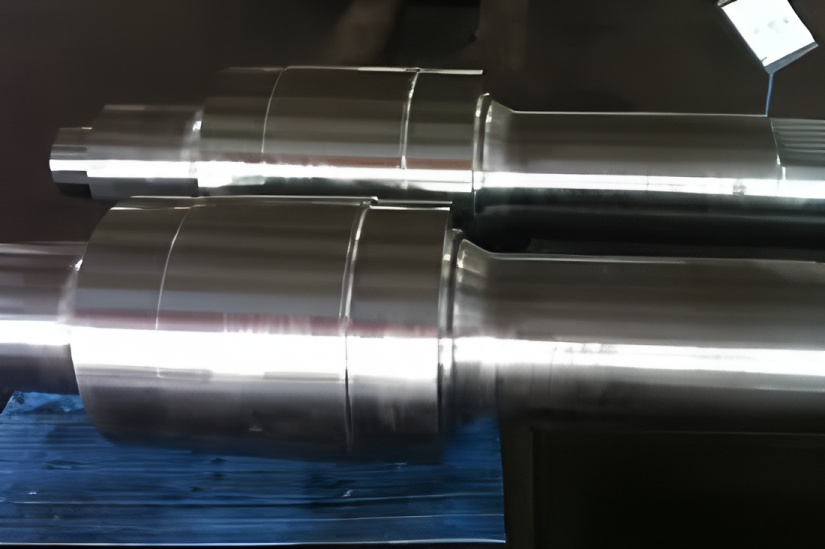The advancement of high-speed steel roll manufacturing technology primarily focuses on enhancing steel purity and uniformity, improving roll strength, and achieving a sound metallurgical bond between the outer layer and the core. Different mills—and even different stands within the same mill—have varying performance requirements for rolls. Suitable manufacturing methods can be selected based on the required roll properties, dimensions, and production costs.
Keywords: HSS rolls
HSS ROLLS Manufacturer
Characteristics of High-Speed Steel Rolls
High Carbide Hardness
Conventional rolls often contain coarse Fe₃C or M₇C₃ eutectic carbides with relatively low hardness.
HSS rolls are typically made from high-carbon, high-vanadium steel alloyed with elements such as Cr, Mo, W, Nb, and Co. During solidification and heat treatment, these form primary and secondary carbides.
While high-chromium iron rolls contain M₇C₃ (2500 HV) and M₂₃C₆ (1600 HV), and indefinite chilled iron rolls contain Fe₃C (1300 HV), HSS rolls comprise harder carbides: MC (3000 HV), M₇C₃ (2500 HV), and M₆C (2000 HV). Increasing the V content promotes the formation of granular VC-type carbides instead of skeletal M₆C, further enhancing wear resistance.Excellent Thermal Stability
HSS rolls contain alloying elements such as W, Cr, Mo, V, and Nb, providing superior thermal stability. Studies show that while conventional roll materials lose hardness significantly as temperature rises, HSS rolls retain a hardness of approximately 500 HV even at 600°C. The addition of Co further enhances this property.Formation of an Oxide Film
During rolling, a continuous, dense, and adherent oxide film forms on the surface of HSS rolls. This film reduces friction between the roll and the material, improves dimensional accuracy and surface quality of the rolled product, prevents steel sticking, and extends roll life. The initial wear of HSS rolls is lower compared to conventional rolls due to rapid oxide film formation.High Hardenability
HSS rolls exhibit excellent hardenability. The hardness decrease from the surface to the core is less than 3 HS within a 50 mm depth, ensuring consistent wear resistance throughout the working layer.Good Toughness
HSS rolls possess better basic mechanical properties—including tensile strength and fracture toughness—than high-chromium iron and indefinite chilled iron rolls, and are comparable to semi-steel rolls.Superior Thermal Crack Resistance
The unique microstructure of HSS effectively inhibits crack initiation and propagation. In practice, HSS rolls demonstrate better thermal crack resistance than high-chromium iron rolls. Normal or minimal regrinding can often eliminate damage from common production incidents, simplifying processing and reducing costs.Exceptional Wear Resistance
HSS rolls significantly increase rolling tonnage—up to ~10,000 tons in F1–F4 stands and ~6,000 tons in the F5 stand—compared to semi-steel, high-chromium iron, and high-nickel-chromium indefinite chilled iron rolls. This results in greatly reduced roll consumption: for instance, consumption is 1/5 that of high-chromium rolls in the F1 stand, 1/7 in F2, 1/13 in F4, and 1/8 in F5 compared to high-nickel-chromium indefinite chilled iron rolls.

Manufacturing Technologies for HSS Rolls
Common methods include forging, casting, spray forming, hot isostatic pressing (HIP), and others. Forged HSS rolls have seen limited adoption. Prevalent industrial casting methods are centrifugal casting, continuous casting composite (CPC), electroslag remelting (ESR), and liquid metal electroslag welding (ESSLM).
Cast HSS Rolls
Enhancements in cast HSS roll manufacturing focus on improving steel purity, uniformity, roll strength, and the metallurgical bonding between the outer layer and core. The choice of manufacturing method depends on required roll performance, size, and cost.
Centrifugal Casting
This process involves sequentially pouring the outer layer and core materials into a rotating mold. Key parameters include centrifugal speed, pouring interval, temperature, and preventing elemental segregation and interface oxidation.
HSS contains elements like W, Cr, Mo, and V, which have significantly different densities from their carbides, leading to segregation under standard conditions. Japanese research identified MC carbide segregation (mainly primary VC) as detrimental to wear resistance.
Adding Nb promotes the formation of dense (V, Mo, Nb)C composite carbides with density closer to molten steel, reducing segregation. However, reducing W and Mo lowers red hardness and wear resistance. Coarse NbC carbides may also cause spalling. Optimizing the V/Nb ratio and process parameters is essential to balancing red hardness, wear resistance, and segregation control.
Increasing centrifugal speed improves density and hardness but may enhance segregation and power consumption. Chinese researchers developed a multi-layer centrifugal casting process to improve bonding layer quality, reducing working layer spalling by 30% and roll breakage by 50–60%, albeit with increased process complexity.
Recent studies attribute segregation to atomic clusters with densities differing from the melt, moving under centrifugal force. Electromagnetic fields can reduce segregation by inducing fluid flow that disrupts cluster formation and promotes equiaxed crystallization.Continuous Casting Composite (CPC)
Developed by Nippon Steel, the CPC method mitigates segregation issues. Molten steel for the outer layer is cast into the gap between a vertical mandrel and a water-cooled mold. With electromagnetic heating and intermittent downward pulling, a composite roll is formed.
CPC-produced rolls have a fine, uniform structure, minimal defects, and a high-strength forged steel core. A Japanese CPC unit can produce rolls with body diameters of 250–850 mm, lengths ≤3000 mm, outer layer thickness ≤100 mm, and weight ≤15,000 kg.
Chinese inventions in CPC-like technologies have enabled production of low-segregation, high-wear-resistance HSS rolls with high W and V content, improving mill utilization and reducing costs.Electroslag Remelting (ESR)
ESR refines steel by reducing inclusions and segregation. The rotary ESR method places a consumable HSS electrode between a forged steel core and a water-cooled mold. As the electrode melts, the core and mold rotate synchronously, and the molten steel forms a metallurgical bond with the core.
This method produces high-cleanliness rolls suitable for cold rolling. However, ESR is expensive, limited to smaller rolls, and involves harmful emissions (e.g., HF, SiF₄). Hitachi produced φ425 mm × 1880 mm semi-HSS rolls via ESR, achieving 97 HS hardness after heat treatment.
Chinese methods using electroslag casting achieve good bonding with a narrow transition layer.Liquid Metal Electroslag Welding (ESSLM)
Developed by Ukraine’s ELMET, ESSLM combines CPC and electroslag refining. A slag pool preheats the mandrel, and molten HSS is poured continuously or intermittently into the gap between the mandrel and a conductive mold. The molten steel is refined by the slag, bonds metallurgically with the mandrel, and solidifies under cooling.
ESSLM-produced rolls are dense, free from defects, and show uniform alloy distribution, hardness, and microstructure. The process is industrialized outside China.
Spray Forming (Osprey) HSS Rolls
Osprey technology atomizes molten metal with inert gas and deposits the droplets onto a substrate to form near-net-shape blanks. Benefits include:
No macrosegregation
Uniform, isotropic structure
Fine, dispersed grains
Low oxygen content
Improved hot workability
Spray-formed HSS rolls have a refined microstructure without coarse eutectic carbides and a metallurgically bonded interface. The UK, US, and Japan have produced spray-formed rolls and composites up to φ800 mm, reporting 1.6–3.6× longer service life than conventional rolls.

Hot Isostatic Pressing (HIP) HSS Rolls
The HIP process, combined with spray granulation in powder metallurgy, yields HSS with superior machinability, toughness, hardness, and dimensional stability. HIP HSS rolls have finer and more uniform carbides than cast rolls, improving thermal fatigue resistance, spalling resistance, and toughness.
Higher carbon and alloy content can be used without compromising carbide morphology. The process involves placing HSS powder around a steel core and sintering under high temperature and pressure (e.g., >1000°C, >100 MPa). Equipment limitations restrict HIP to smaller-diameter rolls.


